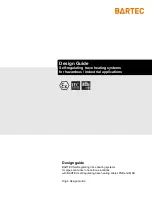IC
L
ive Users Manual - Models ICL-R & IC215S-R
Gated or Chopped Audio
The Analog 1 input is receiving a signal, but some other input has been selected in the RHAON Connect tab. As a trouble shooting aid, the
Analog 1 input will always pass audio if the signal exceeds a threshold level even if some other input is selected. The solution is to select
Analog 1 as the input or disconnect the analog 1 input signal line.
Distorted CobraNet Audio
The chances are that this is an Ethernet network wiring problem. See page ___ for details
NETWORK TROUBLE SHOOTING
A basic understanding of Local Area networks (LANs), Ethernet networks, packet addressing and CobreNet will help you trouble
shoot RHAON systems.
Switched Networks
The Ethernet protocol is a frame-based computer networking technology for local area networks (LANs). This means it is a system for
sending uniquely addressed packets of information from a source to a destination, similar to how one sends a letter through the postal
service. When you mail a letter to Aunt Gertrude across town, the letter doesn’t just go straight from your mailbox to your Aunt’s. It goes to
the post office, where it is sorted and sent along with Gertie’s local mailman. The same holds true for networks, only replace “post office”
with “network switch”.
Switched networks are laid out in a “star” configuration, in that the topology has the switch at the center with links fanning out to all devices
and/or other stars. Typical transport media are CAT5e cable (up to 100m) or optical fiber (up to more than 2km). Communication is han-
dled in a “Point-to-Point” fashion, in that each node communicates solely with the next node attached to it. Using our previous example,
the letter starts in your mailbox and is picked up by your mailman, who then transports your letter to the post office, where it is sorted and
given to Gertrude’s mailman, who then drops it off in her mailbox. How do the switches know where to send the packets? By remember-
ing, of course! Just as the letter to Aunt Gertrude includes a “To” and “From” address, so does a packet. The switch remembers which
“From” addresses come from which port in order to speed up future traffic.
Ethernet Switches
Two of the main distinguishing characteristics between switches are speed and management. The two main speed standards that com-
prise the majority of RHAON installations are 100Base-T (Fast Ethernet) and 1000Base-T (Gigabit Ethernet). While RHAON device con-
nections are Fast Ethernet, either speed may be used as higher speed switches are backwards compatible with those of lower speeds.
The advantage to using Gigabit switches with a RHAON network is that while the individual connections are 100Base-T, the switching
times (the time it takes between packet ingress and egress) are much shorter. This becomes especially important from both a hop and
total nodes standpoint as the size of a network grows. We recommend Gigabit switches for large networks.
Aside from speed, switches come in two flavors: Managed and Unmanaged. An unmanaged switch is essentially a “dumb” black box that
takes packets in and sends them where they need to go. A managed switch, however, allows you much more control. With a managed
switch, one can designate subsets of ports as separate networks, control which types of packets are allowed in or out of certain ports,
monitor current network traffic conditions, port status, etc. For a great number of installations, an unmanaged switch will suffice. However,
for larger or more complex setups, a managed switch becomes critical, though a decent level of networking expertise is required for proper
setup.
SERVICING and TROUBLE SHOOTING (cont)
55


















